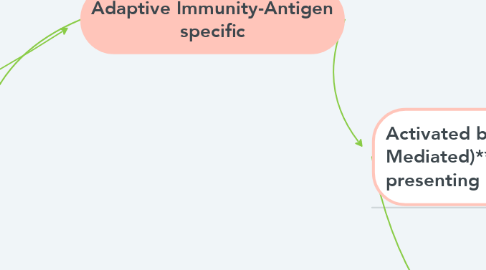
1. Inhibit responses of T & B Cells
2. Cytotoxic T Cells-Attack and destroy infected & abnormal cells displaying antigen
2.1. Secrete poisonous lymphotoxin-destroy target cells
2.2. Release perforin- to destroy the antigenic plasma membrane
2.3. Activate genes in target cell- causes cells to die
3. Memory Tc Cells-Await reappearance of the antigen
4. Suppressor T Cells-Moderate immune response by T cells and B cells
5. Immunity one developed throughout life
6. 4 Properties of immunity
6.1. Specificity
6.2. Versatality
6.3. Memory
6.4. Tolerance
7. Activation By Class I MHC Proteins(cell Mediated) ** Found in membranes of all nucleated cells
7.1. Phagocytes activated & T cells activated
7.2. CD8 T Cells
7.2.1. Found on cytotoxic T cells and suppressor T cells
7.2.2. Respond to antigens on Class I MHC proteins
8. Antigen Presenting Cells (APCs)
9. Indicates that the cell is infected or otherwise abnormal
10. CD8 T Cells
11. Direct Physical & Chemical attack
12. Destruction of Antigen
13. CD8 or CD4 markers** Bind to CD3 receptor complex and prepare for cell activation
14. Active immunity-develops in response to antigen exposure
14.1. Natural acquired active immunity-Develops after exposure to antigen in environment
14.2. Artificial induced active immunity- Develops after administration of an antigen to prevent disease
15. Passive Immunity-Produced by transfer of antibodies from another source
15.1. Naturally acquired passive immunity- Conferred by transfer of maternal antibodies across placenta or in breast milk
15.2. Artificially induced passive immunity- Conferred by administration of antibodies to combat infection
15.2.1. New Material
16. Activated by Class II MHC Proteins (Antibody- Mediated)** Found in membranes of antigen presenting cells (APCs) **Found in lymphocytes
17. Indicates the presence of pathogens, toxin, or foreign proteins
18. CD4 T cells
18.1. Found on T cells
18.2. Respond to antigens on class II MHC proteins
19. Helper T cells-Stimulate immune response by T Cells & B Cels
20. Memory TH Cells- Await reappearance of the antigen
21. Activate B Cells
22. Secretion of antibodies
22.1. Antibody structure-2 parallel pairs polypeptide* 1 pair of heavy chain & 1 pair of light chains
22.1.1. IgG- is the largest & most diverse of antibodies
22.1.1.1. Anti-Rh antibodies produced by Rh-are also IgG antibodies & produce hemolytic disease of the newborn
22.1.1.2. Can cross the placenta & maternal IgG provides passive immunity to fetus durning embryological development
22.1.1.3. is the largest & most diverse of antibodies
22.1.2. IgE
22.1.2.1. Important in the allergic response
22.1.2.2. The cell stimulated to release histamine & other chemicals that accelerate inflammation in the immediate area
22.1.3. IgD
22.1.3.1. Binding can play a role in the sensitization of the B cell involved
22.1.4. IgM
22.1.4.1. Is the first class of antibody secreted after an antigen is encountered
22.1.4.2. Peak response can take 2-wks to develop
22.1.4.3. The anti-A & anti -B antibodies responsible for agglutination of incompatible blood types are IgM antibodies
22.1.4.4. Produced faster than IgG
22.1.5. IgA
22.1.5.1. Found primarily in glandular secretions such as mucus, tears, and semen

